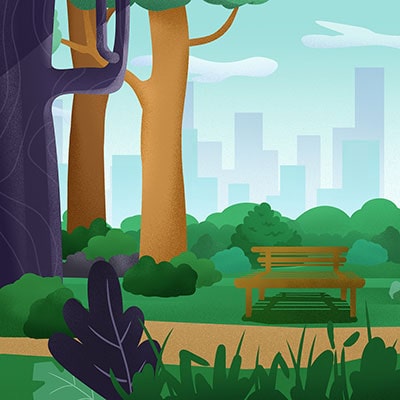
Earlier this month we caught up with Samantha Lagan, who works with Trees for Cities to help make cities across the world a greener, healthier, more attractive place to live. All of the advice and tips about planting and looking after trees was also kindly supplied by Harry Thacker, Urban Forest Manager at Trees for Cities. Check out what Trees for Cities do, how they help cities, and how to properly plant and care for trees in our interview below.
Our interview with Trees for Cities
1. Trees for Cities is the only charity operating on an international level to create greener cities. How do you do this?
In cities other than London, where we are based, our model is to work in partnership with local delivery organisations. In the UK these may be City Councils or community groups, whilst overseas we work with non-governmental organisations (NGOs).
2. Trees for Cities have worked with over 70,000 people across the UK and overseas to improve their local parks, streets, estates, and schools. How do you engage communities at such a large scale?
Each project we do at Trees for Cities requires dedicated time for community engagement. Once we start a project, we look at the local community and reach out to a range of diverse groups, from schools to allotment societies, residents associations to faith groups. We invite them to community meetings where they can learn more about the project and input into the design, before bringing everyone together for the community planting day. We are developing our cluster approach at the moment that brings communities together from these different projects and maximises the relationships we build.
3. How do you decide which locations you work with to help improve the local areas?
We work with landowners and community groups to identify locations where tree planting will have significant benefits for local communities. Our projects transform local spaces and create high-quality places for people to unwind from the stresses of urban living. Trees help to clean and cool the air, connect us with nature and enrich our surroundings so we look for projects to maximise these impacts.

4. Are there particular trees which you tend to plant?
Not really, it’s important that we plant a broad range of native and non-native species. The idea behind this is to increase local genotypic diversity, which helps to build resilience to pest and disease outbreaks and the threats posed to the establishing trees by global warming and the increasingly harsh urban environment.
5. What is the best way to plant a tree?
The key when planting a tree is to get the depth right. Too deep or too shallow and the tree may run into complications later in life. Often urban soils are extremely tough places for roots, so we always work hard to ameliorate soil conditions as much as possible by de-compacting soils and working to improve soil structure and composition. Another important consideration is securing the tree so that the roots can establish properly. We do this using stakes and ties, making sure that we allow the tree to move naturally in the wind, but keeping the roots secure in the ground until the tree is established.
6. Is it essential that you use mulch when planting a new tree? And if so, how much mulch do you need?
Mulch is great! It replicates the natural forest environment in which most trees evolved. It increases soil water retention, helps prevent soil compaction, and creates a favourable environment for worms and soil biota, which are essential for maintaining good soil structure. It also prevents competition from grass which can take nutrients and water away from the establishing trees.
We usually mulch in a circle with a 1m radius around the tree, to about 5-10cm depth .
7. What is the best way to protect a newly planted tree from being trodden on/subjected to disease?
We put cages around vulnerable trees to protect them from accidental damage or vandalism. It’s very difficult to prevent disease. Having a progressive attitude to plant biosecurity is an important start.
Regularly inspecting trees for signs of disease is also vital, so that outbreaks can be effectively managed.
8. Is there an easy way to spot damage or disease on trees to make sure it stays healthy? Are there ways to treat disease on trees?
If you inspect your trees regularly it’s much easier to notice the changes or abnormalities that can signify the tree is in poor health, but It’s best to get the advice of a suitably qualified professional where possible. Some diseases are treatable and many can be controlled by taking relatively simple precautions, the difficulty is often correctly identifying the pest or disease in question.

9. How often do trees need to be watered, both at newly planted and more developed stages?
This depends on the species, soil characteristics, and climatic conditions. Trees need regular watering for the first three years until they are able to put out new roots and establish in their environment. Depending on species and conditions this can be weekly, every few days, or even daily in some cases. After they are established the trees should be able to source all the water they need, however even established trees can benefit from watering if conditions are tough.
10. How often do trees need to be pruned? Are there any methods of pruning you would suggest?
Again this depends on species and location. For some species like fruit trees, regular pruning is essential. Other species, in the right location, may never need to be pruned. Trees are incredibly sensitive and pruning is a delicate operation, so it’s best to seek the advice of a trained professional before undertaking any pruning at home.




